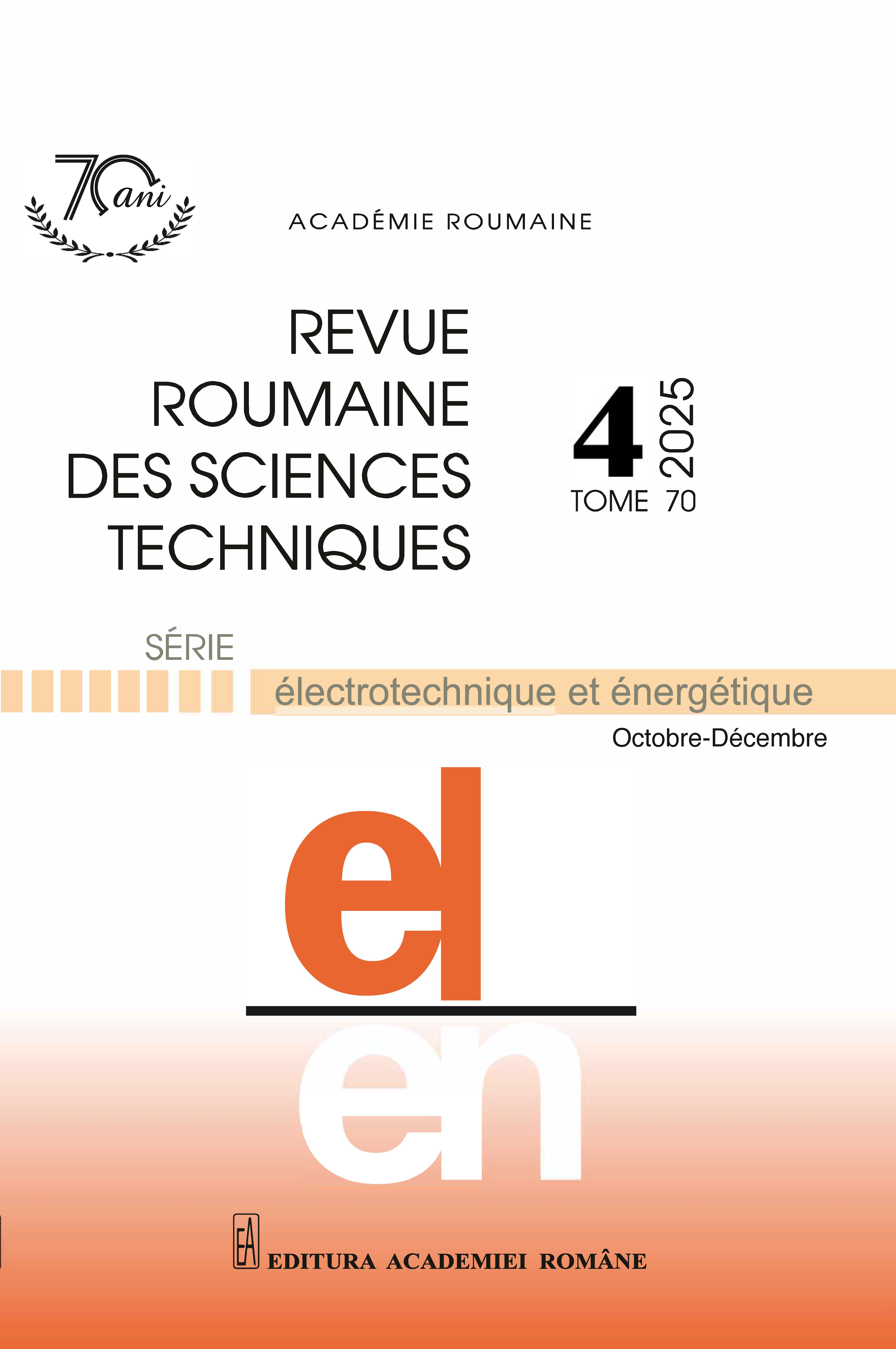ÉVOLUTION DE LA QUALITÉ DE L'ÉNERGIE POUR LES SYSTÈMES DE CONVERSION D'ÉNERGIE ÉOLIENNE UTILISANT UN ONDULEUR À SOURCE Z INTÉGRÉ ET UN GÉNÉRATEUR SYNCHRONE À AIMANTS PERMANENTS
DOI :
https://doi.org/10.59277/RRST-EE.2025.4.5Mots-clés :
Générateur synchrone à aimant permanent (PMSG), Onduleur à source Z intégré (EZSI), Distorsion harmonique totale (THD), Contrôleur à logique floue (FLC), Onduleur à source Z (ZSI), Système de conversion d'énergie éolienne (WECS)Résumé
Cette étude se concentre sur deux objectifs clés : maximiser l'énergie éolienne et fournir au système une électricité de haute qualité. Un générateur synchrone à aimant permanent et un onduleur Z-Source intégré sont utilisés dans cette configuration afin d’augmenter la tension. Le générateur synchrone à aimant permanent est utilisé pour ses caractéristiques uniques, notamment ses excellentes performances, son faible poids et son faible volume, ainsi que le fait qu'il ne nécessite pas de source d'alimentation externe pour exciter ses aimants permanents. L'onduleur Z-Source intégré à liaison CC sert à connecter ce générateur au réseau électrique. En général, la connexion Z-Source nécessite de nombreux tours d'enroulement du transformateur ; cependant, dans ce cas, des enroulements de puissance inférieurs sont utilisés pour l'inductance à la place du transformateur. Ainsi, le gain de tension est également équilibré par les capacités parallèles. De plus, la distribution symétrique de la tension et du courant sur le réseau, ainsi que la réduction des contraintes de tension, constituent des avantages de la technologie intégrée. La méthode recommandée, l'onduleur Z-Source intégré, est spécifiquement contrôlée par un contrôleur à logique floue qui suit également la puissance maximale du système éolien et réduit la distorsion harmonique totale à 0,86 %, comme l'indique MATLAB. Cependant, les résultats ont également été confirmés à l'aide d'un prototype expérimental.
Références
(1) M.E. Şahin, Comparison of IG and DFIG for wind power generation systems, Gazi Journal of Engineering Sciences, 6, 3, pp. 230–241 (2020).
(2) N.G. Khani, Improving fault ride-through capability of induction generator-based wind farm using static compensator during asymmetrical faults, Electrical Energy System (2021).
(3) A.P. G and H.S. H, A comprehensive review of fault ride-through capability of wind turbines with grid-connected doubly fed induction generator, Int Trans Electr Energy Syst (2020).
(4) R. Elumalai, Maximum power quality tracking of ANN controller-based DFIG for wind energy conversion system, Rev. Roum. Sci. Techn. – Électrotechn. et Énerg., 69, 2, pp. 189–192 (2024).
(5) G. Shahgholian and S.M. Zanjani, A study of voltage sag in distribution system and evaluation of the effect of wind farm equipped with doubly-fed induction generator, Rev. Roum. Sci. Techn. – Électrotechn. et Énerg., 68, 3, pp. 271–276 (2023).
(6) I. Yaichi and A. Semmah, Control of doubly-fed induction generator using artificial neural network controller, Rev. Roum. Sci. Techn. – Électrotechn. et Énerg., 68, 1, pp. 46–51 (2023).
(7) M. Mohan and K.P. Vittal, Modeling and simulation of PMSG-based wind power generation system, In IEEE Xplore, 3rd IEEE International Conference on Recent Trends in Electronics, Information & Communication Technology (RTEICT) (2018).
(8) P. Chaturvedi and D.K. Palwalia, PMSG-based standalone wind energy conversion system with power quality enhancement, International Journal of Renewable Energy Research-IJRER, 13, 2 (2023).
(9) S. Data, A. Islam, T. Saikia, and S. Adhikari, Performance study of a grid-connected permanent magnet synchronous generator-based wind turbine system, In IEEE Xplore, International Conference on Computer, Communication, Chemical, Materials and Electronic Engineering (IC4ME2) (2020).
(10) A.J. Balbino, B.D.S. Nora, and T.B. Lazzarin, An improved mechanical sensor less maximum power point tracking method for permanent-magnet synchronous generator-based small wind turbine systems, IEEE Trans Ind Electr, 69, 5, pp. 4765–4775 (2021).
(11) S. Piriienko, T. Röser, M. Neuburger, and A. Balakhontsev, Current source gate drivers for 3-phase VSI operated in small-scale wind turbine systems, International Journal of Electrical Power & Energy Systems, 141 (2022).
(12) A.Chakrabarti, P.K. Sadhu, and P. Pal, A novel dead-time elimination strategy for voltage source inverters in induction heating systems through fractional order controllers, Rev. Roum. Sci. Techn. – Électrotechn. et Énerg., 67, 2, pp. 181–185 (2022).
(13) Z. Alnasir and M. Kazerani, Dynamic average modeling of a CSI-based small-scale standalone wind energy conversion system, In IEEE Xplore, 2018 IEEE Electrical Power and Energy Conference (EPEC) (2019).
(14) X. Tan and J. Dai, A novel converter configuration for wind applications using PWM-CSI with diode rectifier and buck converter, Electrical Engineering (2011).
(15) S.A. Kamilu, A. Mohammed, B. Ummai, S. Ikuforiji, A. Michael, and A. Muyideen, Maximum boost PWM control technique of three-phase ZSI-based wind energy conversion systems, International Journal of Scientific Research in Science, Engineering and Technology, 6, 5, pp. 191–201 (2019).
(16) S. Nath, H.C. Nannam, and A. Banerjee, Grey wolf-optimized MPPT controller for q-ZSI-based grid-tied wind power generation system, Electr Eng, 106, pp. 3445–3460 (2024).
(17) M. Abbasi, A.H. Eslahchi, and M. Mardaneh, Two symmetric extended-boost embedded switched-inductor quasi-Z-source inverter with reduced ripple continuous input current, IEEE Transactions on Industrial Electronics, 65, 6, pp. 5096–5104 (2018).
(18) O.B. Heddurshetti, J. Chavan, S. Sanadi, V. Patil, and K. Magadum, Design and implementation of trans-Z-source inverter, International Journal of Emerging Technologies and Innovative Research, 5, 9, pp. 762–766 (2018).
(19) A. Beddar, H. Bouzekri, B. Babes, and H. Afghoul, Real-time implementation of improved fractional order proportional-integral controller for grid-connected wind energy conversion system, Rev. Roum. Sci. Techn. – Électrotechn. et Énerg., 61, 4, pp. 402–407 (2016).
Téléchargements
Publiée
Numéro
Rubrique
Licence
(c) Copyright REVUE ROUMAINE DES SCIENCES TECHNIQUES — SÉRIE ÉLECTROTECHNIQUE ET ÉNERGÉTIQUE 2025

Ce travail est disponible sous licence Creative Commons Attribution - Pas d'Utilisation Commerciale - Pas de Modification 4.0 International.


